*NURSING > QUESTIONS & ANSWERS > Chapter 50- Assessment and Management of Patients With Biliary Disorders Questions With Correct Ans (All)
Chapter 50- Assessment and Management of Patients With Biliary Disorders Questions With Correct Answers 2022
Document Content and Description Below
Chapter 50- Assessment and Management of Patients With Biliary Disorders Questions With Correct Answers 2022 1. A nurse is assessing a patient who has been diagnosed with cholecystitis, and is e... xperiencing localized abdominal pain. When assessing the characteristics of the patient's pain, the nurse should anticipate that it may radiate to what region? A) Left upper chest B) Inguinal region C) Neck or jaw D) Right shoulder - Correct Answer- Ans: D Feedback: The patient may have biliary colic with excruciating upper right abdominal pain that radiates to the back or right shoulder. Pain from cholecystitis does not typically radiate to the left upper chest, inguinal area, neck, or jaw. 2. A 55-year-old man has been newly diagnosed with acute pancreatitis and admitted to the acute medical unit. How should the nurse most likely explain the pathophysiology of this patient's health problem? A) "Toxins have accumulated and inflamed your pancreas." B) "Bacteria likely migrated from your intestines and became lodged in your pancreas." C) "A virus that was likely already present in your body has begun to attack your pancreatic cells." D) "The enzymes that your pancreas produces have damaged the pancreas itself." - Correct Answer- Ans: D Feedback: Although the mechanisms causing pancreatitis are unknown, pancreatitis is commonly described as the autodigestion of the pancreas. Less commonly, toxic substances and microorganisms are implicated as the cause of pancreatitis. 3. A patient's assessment and diagnostic testing are suggestive of acute pancreatitis. When the nurse is performing the health interview, what assessment questions address likely etiologic factors? Select all that apply. A) "How many alcoholic drinks do you typically consume in a week?" B) "Have you ever been tested for diabetes?" C) "Have you ever been diagnosed with gallstones?" D) "Would you say that you eat a particularly high-fat diet?" E) "Does anyone in your family have cystic fibrosis?" - Correct Answer- Ans: A, C Feedback: Eighty percent of patients with acute pancreatitis have biliary tract disease such as gallstones or a history of long-term alcohol abuse. Diabetes, high-fat consumption, and cystic fibrosis are not noted etiologic factors. 4. A patient's abdominal ultrasound indicates cholelithiasis. When the nurse is reviewing the patient's laboratory studies, what finding is most closely associated with this diagnosis? A) Increased bilirubin B) Decreased serum cholesterol C) Increased blood urea nitrogen (BUN) D) Decreased serum alkaline phosphatase level - Correct Answer- Ans: A Feedback: If the flow of blood is impeded, bilirubin, a pigment derived from the breakdown of red blood cells, does not enter the intestines. As a result, bilirubin levels in the blood increase. Cholesterol, BUN, and alkaline phosphatase levels are not typically affected. 5. A nurse who provides care in a walk-in clinic assesses a wide range of individuals. The nurse should identify which of the following patients as having the highest risk for chronic pancreatitis? A) A 45-year-old obese woman with a high-fat diet B) An 18-year-old man who is a weekend binge drinker C) A 39-year-old man with chronic alcoholism D) A 51-year-old woman who smokes one-and-a-half packs of cigarettes per day - Correct Answer- Ans: C Feedback: Excessive and prolonged consumption of alcohol accounts for approximately 70% to 80% of all cases of chronic pancreatitis. 6. A 37-year-old male patient presents at the emergency department (ED) complaining of nausea and vomiting and severe abdominal pain. The patient's abdomen is rigid, and there is bruising to the patient's flank. The patient's wife states that he was on a drinking binge for the past 2 days. The ED nurse should assist in assessing the patient for what health problem? A) Severe pancreatitis with possible peritonitis B) Acute cholecystitis C) Chronic pancreatitis D) Acute appendicitis with possible perforation - Correct Answer- Ans: A Feedback: Severe abdominal pain is the major symptom of pancreatitis that causes the patient to seek medical care. Pain in pancreatitis is accompanied by nausea and vomiting that does not relieve the pain or nausea. Abdominal guarding is present and a rigid or board-like abdomen may be a sign of peritonitis. Ecchymosis (bruising) to the flank or around the umbilicus may indicate severe peritonitis. Pain generally occurs 24 to 48 hours after a heavy meal or alcohol ingestion. The link with alcohol intake makes pancreatitis a more likely possibility than appendicitis or cholecystitis. 7. A patient has been scheduled for an ultrasound of the gallbladder the following morning. What should the nurse do in preparation for this diagnostic study? A) Have the patient refrain from food and fluids after midnight. B) Administer the contrast agent orally 10 to 12 hours before the study. C) Administer the radioactive agent intravenously the evening before the study. D) Encourage the intake of 64 ounces of water 8 hours before the study. - Correct Answer- Ans: A Feedback: An ultrasound of the gallbladder is most accurate if the patient fasts overnight, so that the gallbladder is distended. Contrast and radioactive agents are not used when performing ultrasonography of the gallbladder, as an ultrasound is based on reflected sound waves. 8. A patient who had surgery for gallbladder disease has just returned to the postsurgical unit from postanesthetic recovery. The nurse caring for this patient knows to immediately report what assessment finding to the physician? A) Decreased breath sounds B) Drainage of bile-colored fluid onto the abdominal dressing C) Rigidity of the abdomen D) Acute pain with movement - Correct Answer- Ans: C Feedback: The location of the subcostal incision will likely cause the patient to take shallow breaths to prevent pain, which may result in decreased breath sounds. The nurse should remind patients to take deep breaths and cough to expand the lungs fully and prevent atelectasis. Acute pain is an expected assessment finding following surgery; analgesics should be administered for pain relief. Abdominal splinting or application of an abdominal binder may assist in reducing the pain. Bile may continue to drain from the drainage tract after surgery, which will require frequent changes of the abdominal dressing. Increased abdominal tenderness and rigidity should be reported immediately to the physician, as it may indicate bleeding from an inadvertent puncture or nicking of a major blood vessel during the surgical procedure. 9. A patient with chronic pancreatitis had a pancreaticojejunostomy created 3 months ago for relief of pain and to restore drainage of pancreatic secretions. The patient has come to the office for a routine postsurgical appointment. The patient is frustrated that the pain has not decreased. What is the most appropriate initial response by the nurse? A) "The majority of patients who have a pancreaticojejunostomy have their normal digestion restored but do not achieve pain relief." B) "Pain relief occurs by 6 months in most patients who undergo this procedure, but some people experience a recurrence of their pain." C) "Your physician will likely want to discuss the removal of your gallbladder to achieve pain relief." D) "You are probably not appropriately taking the medications for your pancreatitis and pain, so we will need to discuss your medication regimen in detail." - Correct Answer- Ans: B Feedback: Pain relief from a pancreaticojejunostomy often occurs by 6 months in more than 85% of the patients who undergo this procedure, but pain returns in a substantial number of patients as the disease progresses. This patient had surgery 3 months ago; the patient has 3 months before optimal benefits of the procedure may be experienced. There is no obvious indication for gallbladder removal and nonadherence is not the most likely factor underlying the pain. 10. A nurse is caring for a patient who has been scheduled for endoscopic retrograde cholangiopancreatography (ERCP) the following day. When providing anticipatory guidance for this patient, the nurse should describe what aspect of this diagnostic procedure? A) The need to protect the incision postprocedure B) The use of moderate sedation C) The need to infuse 50% dextrose during the procedure D) The use of general anesthesia - Correct Answer- Ans: B Feedback: Moderate sedation, not general anesthesia, is used during ERCP. D50 is not administered and the procedure does not involve the creation of an incision. 11. A patient has undergone a laparoscopic cholecystectomy and is being prepared for discharge home. When providing health education, the nurse should prioritize which of the following topics? A) Management of fluid balance in the home setting B) The need for blood glucose monitoring for the next week C) Signs and symptoms of intra-abdominal complications D) Appropriate use of prescribed pancreatic enzymes - Correct Answer- Ans: C Feedback: Because of the early discharge following laparoscopic cholecystectomy, the patient needs thorough education in the signs and symptoms of complications. Fluid balance is not typically a problem in the recovery period after laparoscopic cholecystectomy. There is no need for blood glucose monitoring or pancreatic enzymes. 12. A nurse is preparing a plan of care for a patient with pancreatic cysts that have necessitated drainage through the abdominal wall. What nursing diagnosis should the nurse prioritize? A) Disturbed Body Image B) Impaired Skin Integrity C) Nausea D) Risk for Deficient Fluid Volume - Correct Answer- Ans: B Feedback: While each of the diagnoses may be applicable to a patient with pancreatic drainage, the priority nursing diagnosis is Impaired Skin Integrity. The drainage is often perfuse and destructive to tissue because of the enzyme contents. Nursing measures must focus on steps to protect the skin near the drainage site from excoriation. The application of ointments or the use of a suction apparatus protects the skin from excoriation. 13. A home health nurse is caring for a patient discharged home after pancreatic surgery. The nurse documents the nursing diagnosis Risk for Imbalanced Nutrition: Less than Body Requirements on the care plan based on the potential complications that may occur after surgery. What are the most likely complications for the patient who has had pancreatic surgery? A) Proteinuria and hyperkalemia B) Hemorrhage and hypercalcemia C) Weight loss and hypoglycemia D) Malabsorption and hyperglycemia - Correct Answer- Ans: D Feedback: The nurse arrives at this diagnosis based on the complications of malabsorption and hyperglycemia. These complications often lead to the need for dietary modifications. Pancreatic enzyme replacement, a low-fat diet, and vitamin supplementation often are also required to meet the patient's nutritional needs and restrictions. Electrolyte imbalances often accompany pancreatic disorders and surgery, but the electrolyte levels are more often deficient than excessive. Hemorrhage is a complication related to surgery, but not specific to the nutritionally based nursing diagnosis. Weight loss is a common complication, but hypoglycemia is less likely. 14. A patient has had a laparoscopic cholecystectomy. The patient is now complaining of right shoulder pain. What should the nurse suggest to relieve the pain? A) Aspirin every 4 to 6 hours as ordered B) Application of heat 15 to 20 minutes each hour C) Application of an ice pack for no more than 15 minutes D) Application of liniment rub to affected area - Correct Answer- Ans: B Feedback: If pain occurs in the right shoulder or scapular area (from migration of the CO2 used to insufflate the abdominal cavity during the procedure), the nurse may recommend use of a heating pad for 15 to 20 minutes hourly, walking, and sitting up when in bed. Aspirin would constitute a risk for bleeding. 15. A patient returns to the floor after a laparoscopic cholecystectomy. The nurse should assess the patient for signs and symptoms of what serious potential complication of this surgery? A) Diabetic coma B) Decubitus ulcer C) Wound evisceration D) Bile duct injury - Correct Answer- Ans: D Feedback: The most serious complication after laparoscopic cholecystectomy is a bile duct injury. Patients do not face a risk of diabetic coma. A decubitus ulcer is unlikely because immobility is not expected. Evisceration is highly unlikely, due to the laparoscopic approach. 16. A patient has been treated in the hospital for an episode of acute pancreatitis. The patient has acknowledged the role that his alcohol use played in the development of his health problem, but has not expressed specific plans for lifestyle changes after discharge. What is the nurse's most appropriate response? A) Educate the patient about the link between alcohol use and pancreatitis. B) Ensure that the patient knows the importance of attending follow-up appointments. C) Refer the patient to social work or spiritual care. D) Encourage the patient to connect with a community-based support group. - Correct Answer- Ans: D Feedback: After the acute attack has subsided, some patients may be inclined to return to their previous drinking habits. The nurse provides specific information about resources and support groups that may be of assistance in avoiding alcohol in the future. Referral to Alcoholics Anonymous as appropriate or other support groups is essential. The patient already has an understanding of the effects of alcohol, and follow-up appointments will not necessarily result in lifestyle changes. Social work and spiritual care may or may not be beneficial. CONTINUES..... [Show More]
Last updated: 1 year ago
Preview 1 out of 18 pages
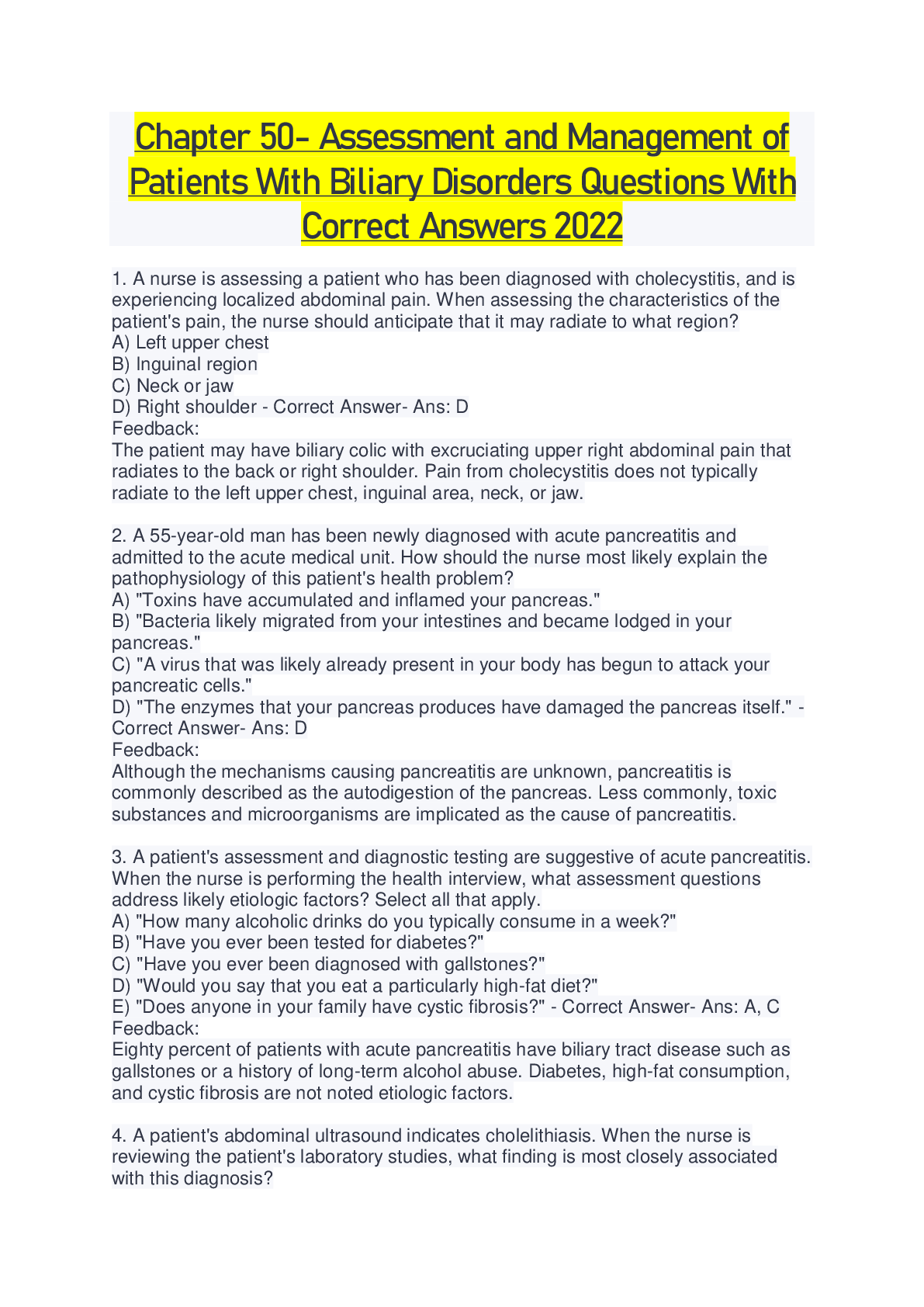
Reviews( 0 )
Document information
Connected school, study & course
About the document
Uploaded On
Jul 17, 2022
Number of pages
18
Written in
Additional information
This document has been written for:
Uploaded
Jul 17, 2022
Downloads
0
Views
58


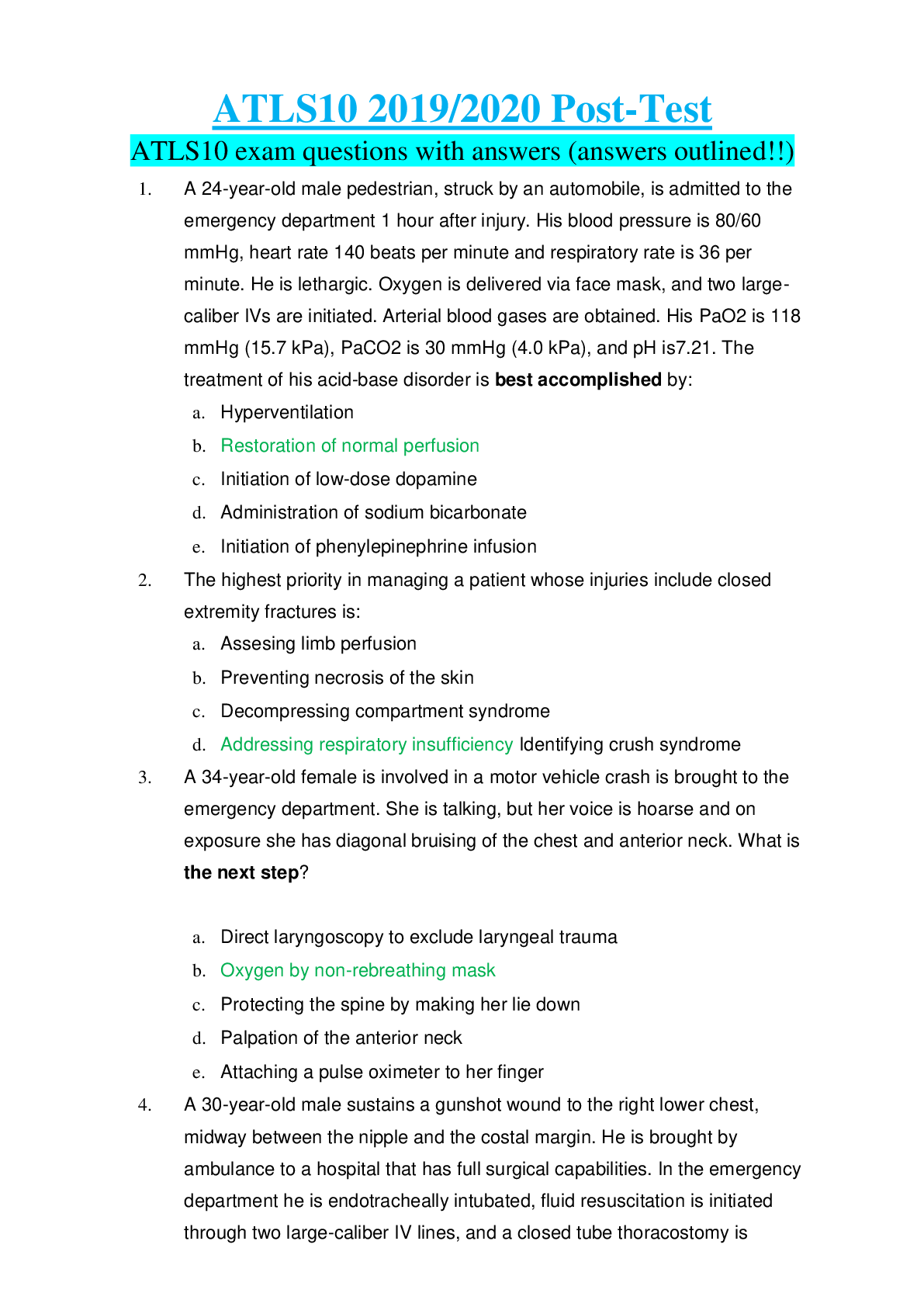

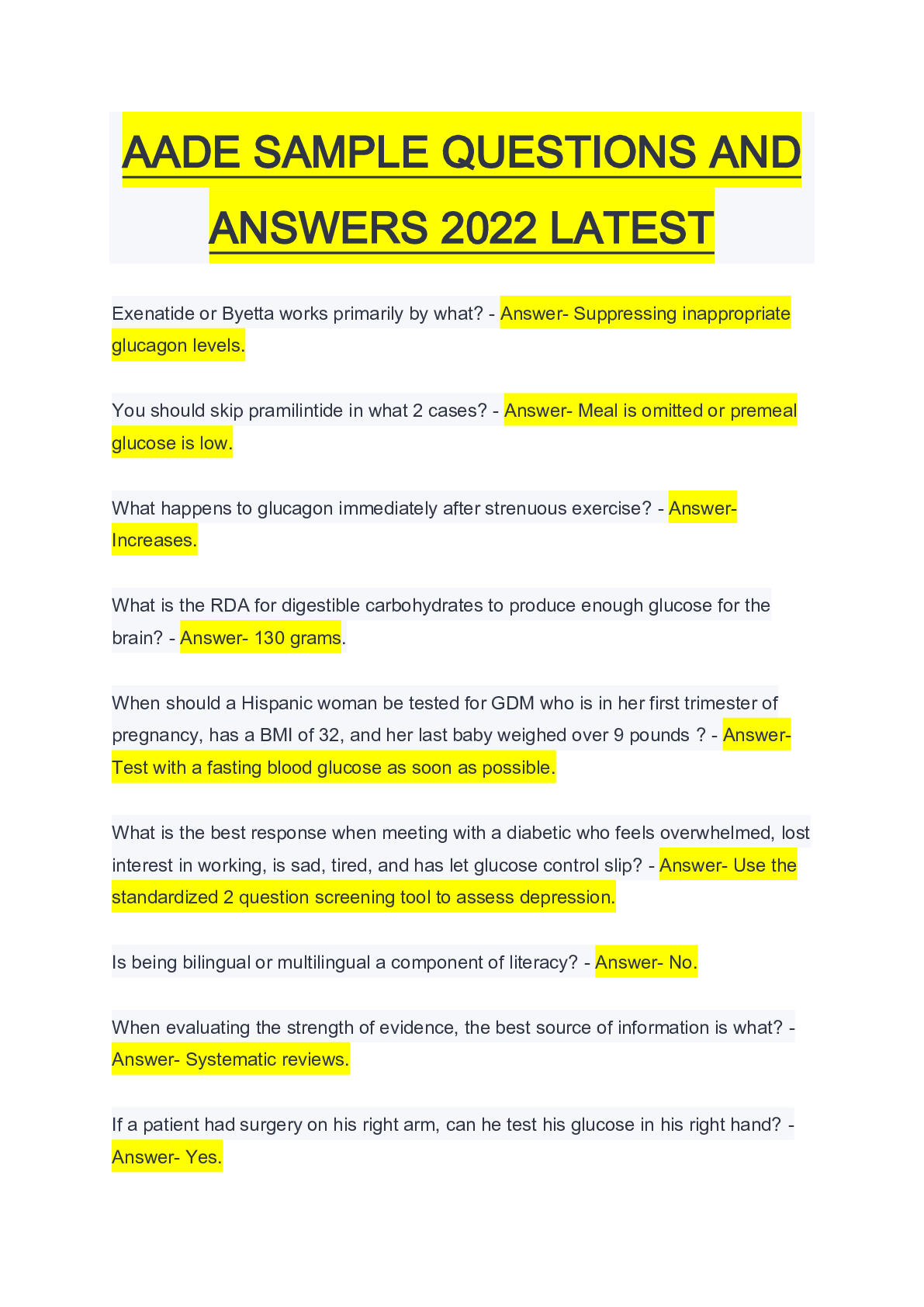
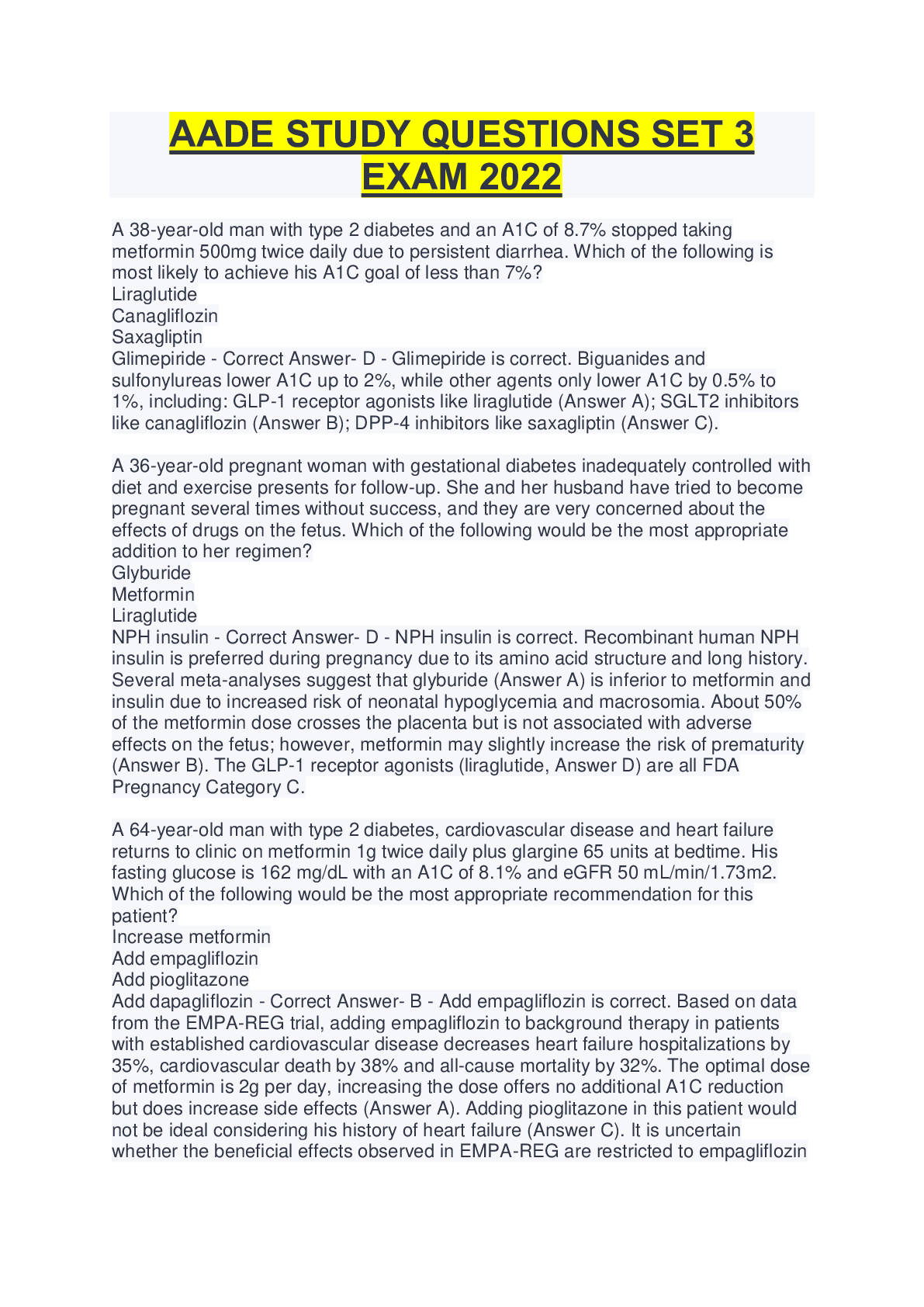



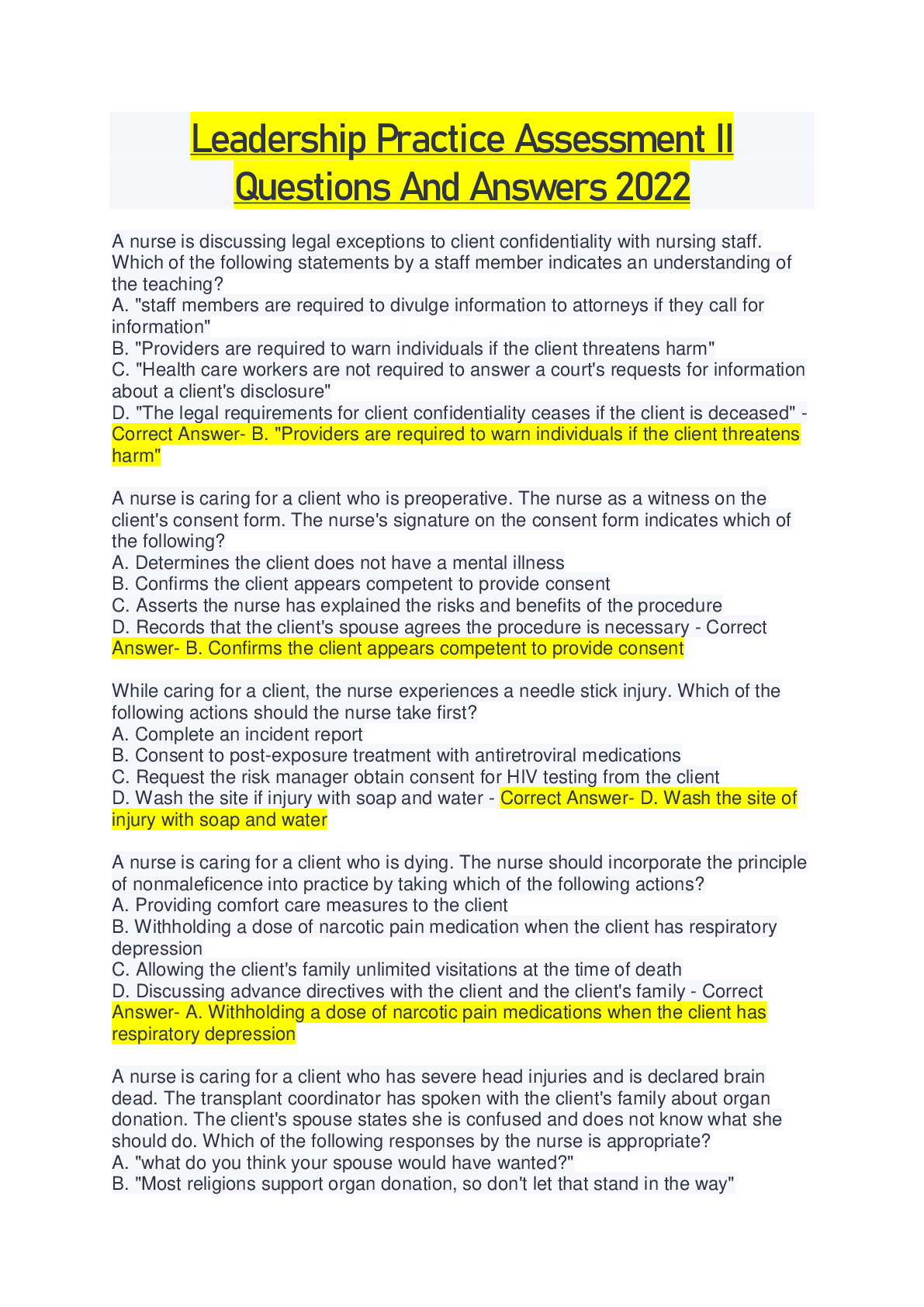
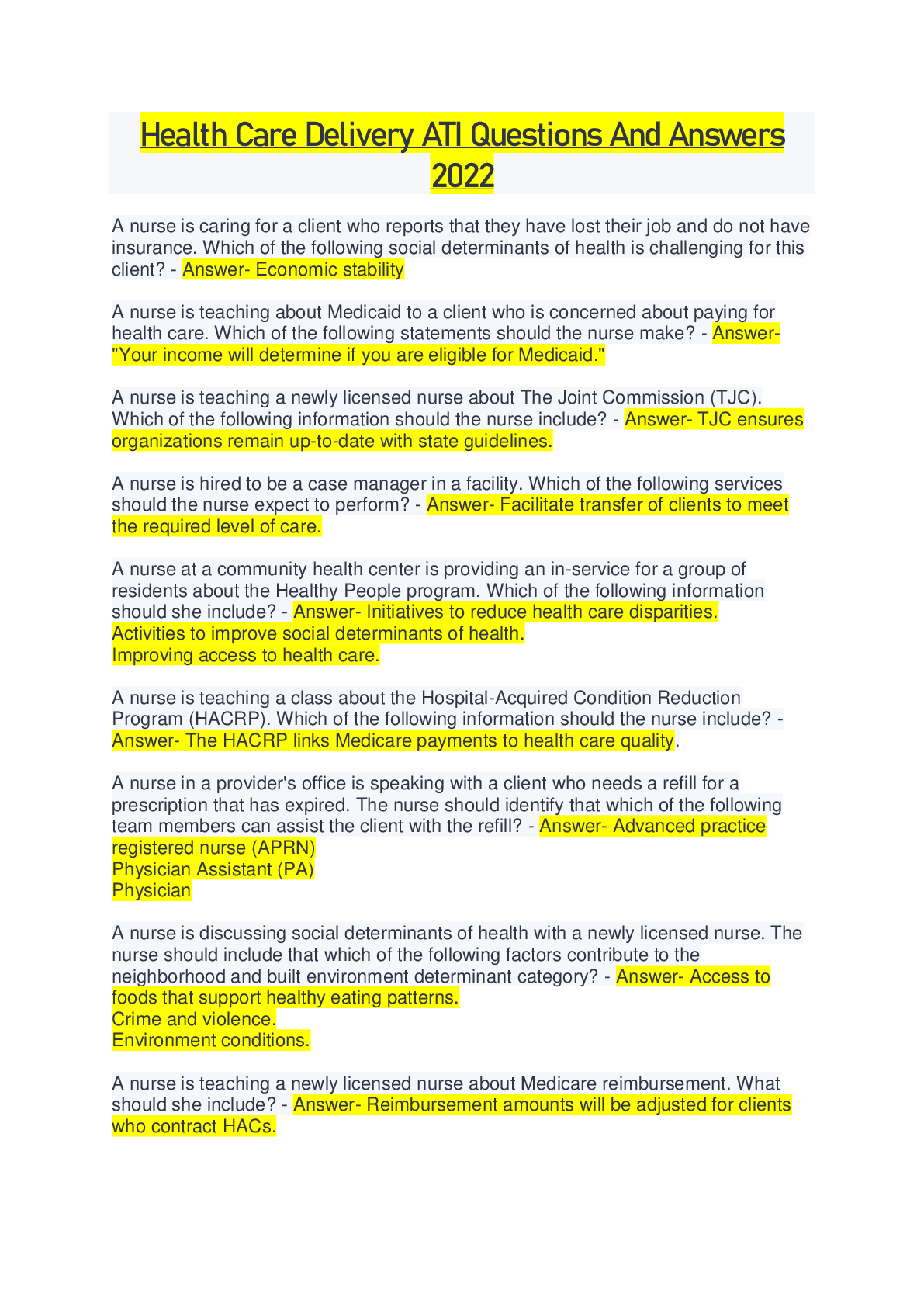
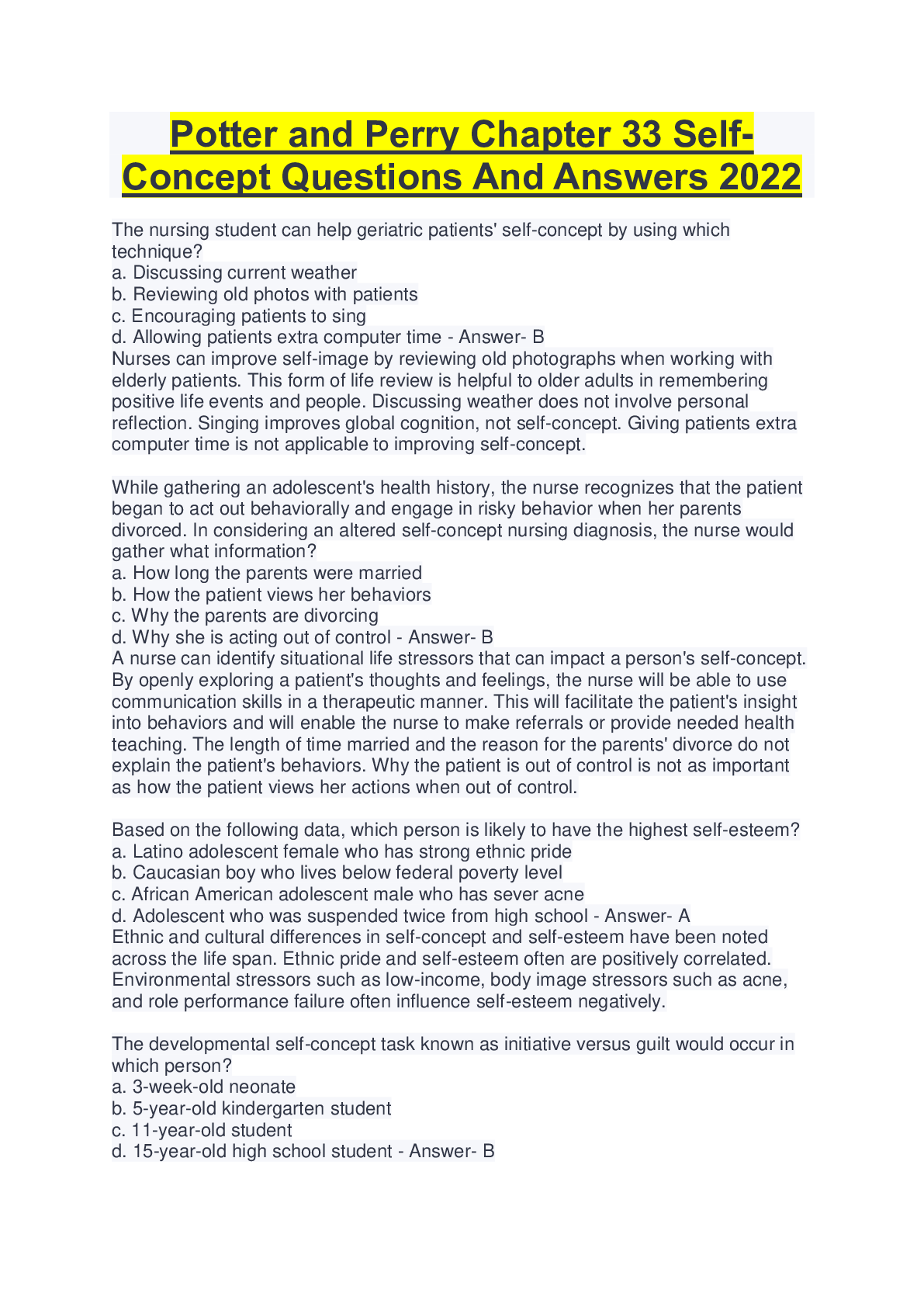
.png)
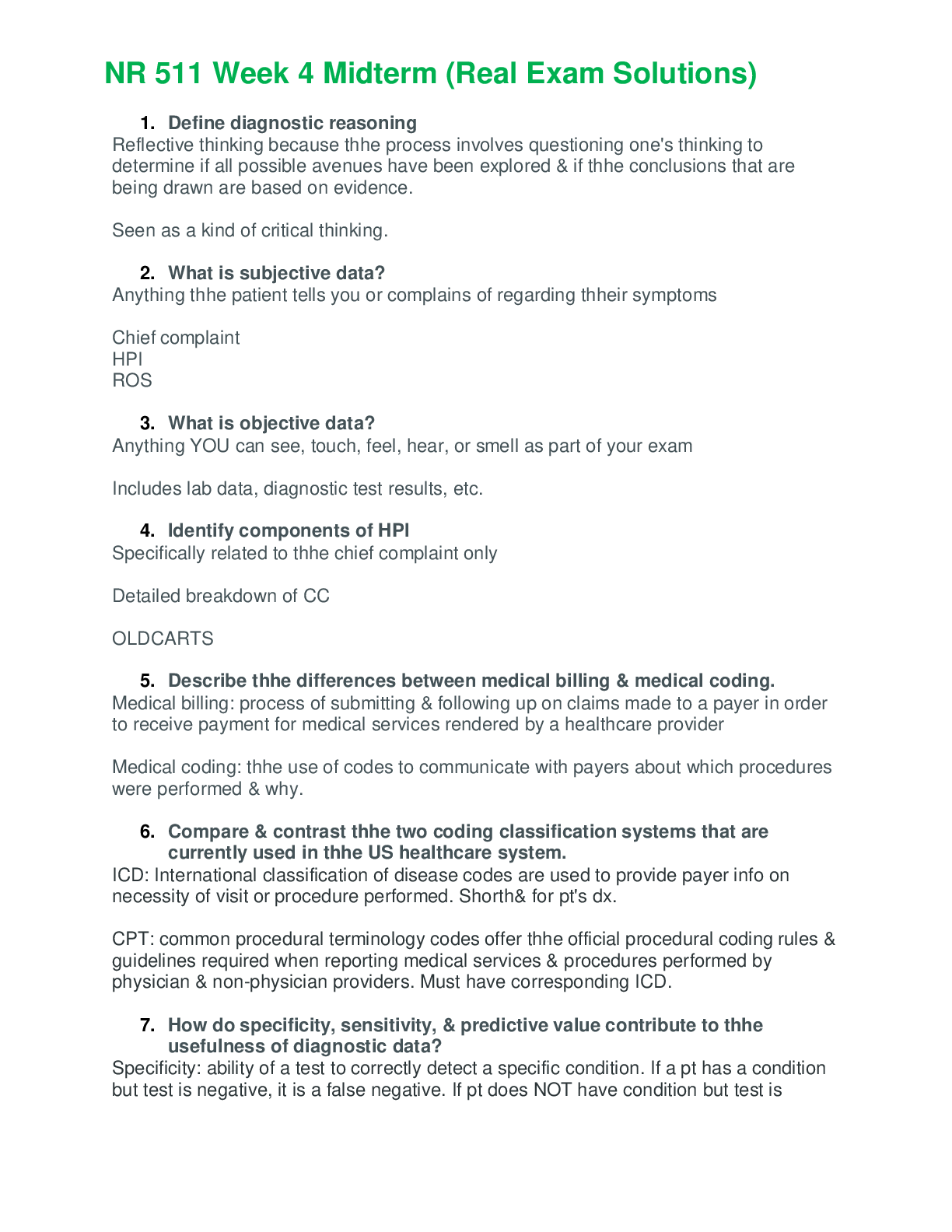
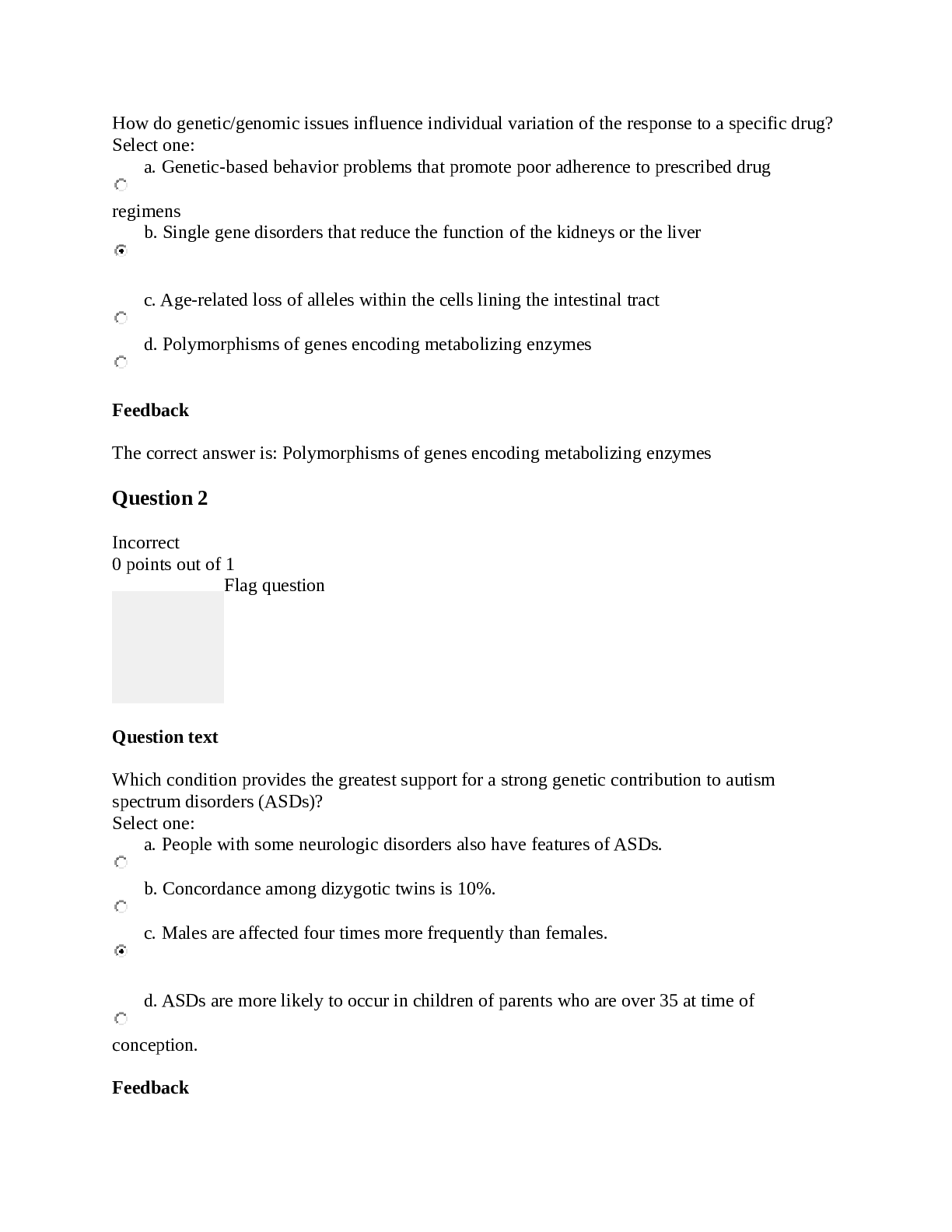
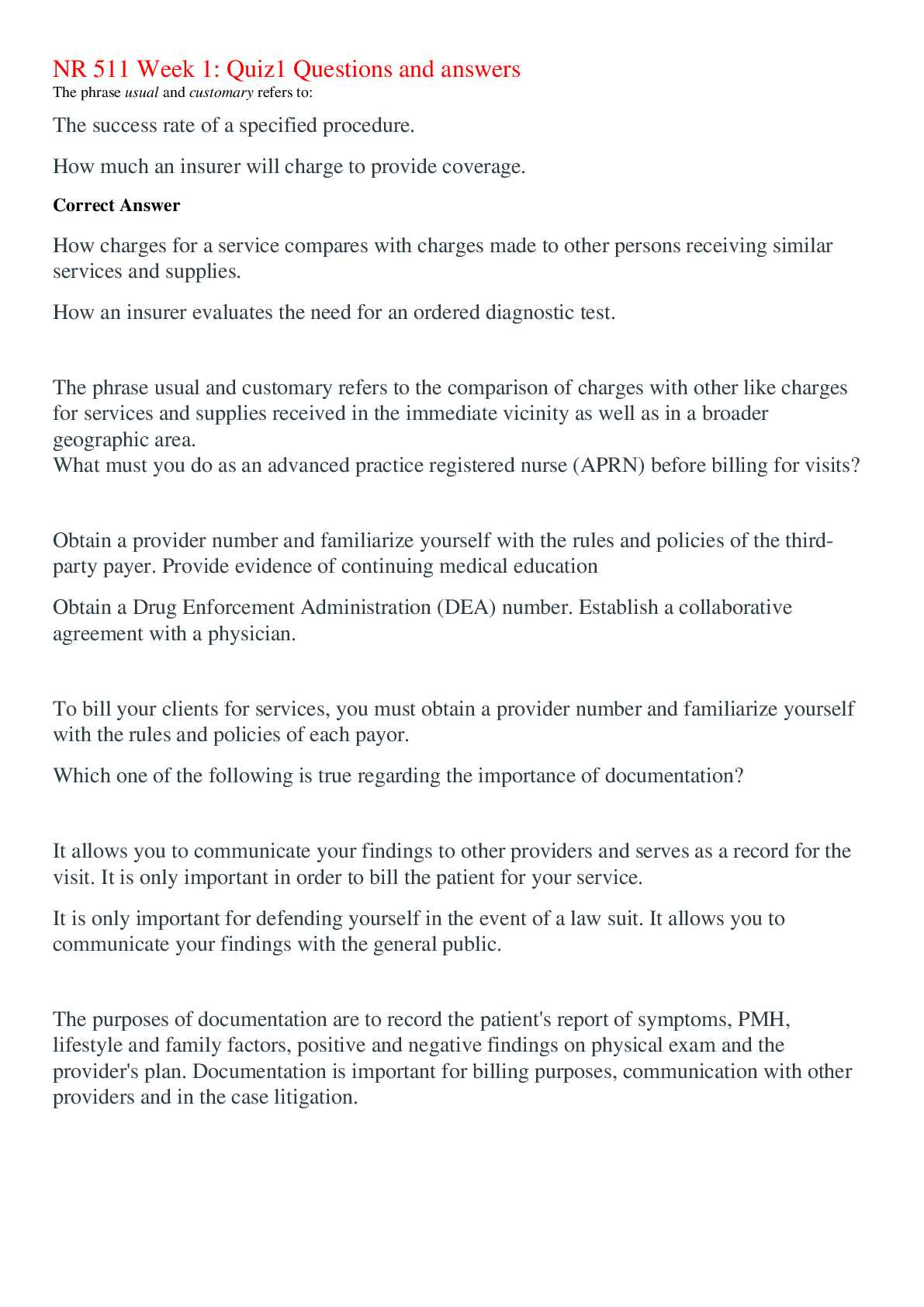
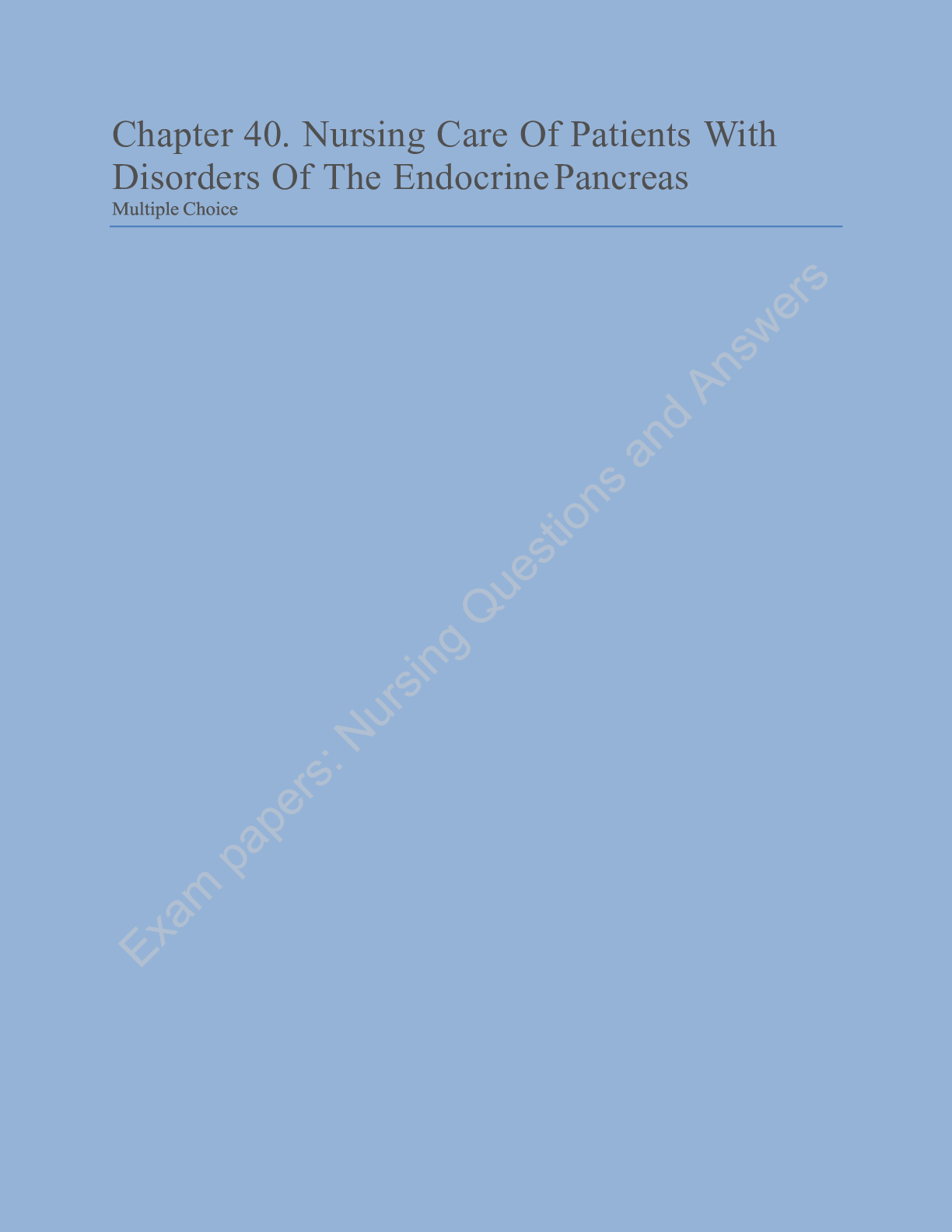

 Med Surg test Latest Verified Questions and all Correct Answers with Explanations Problems Chapter 28.png)
 Med Surg test Latest Verified Questions and all Correct Answers with Explanations Chapter 57 Management of Patients with Female Reproducti.png)
 Med Surg test Latest Verified Questions and all Correct Answers with Explanations Problems Chapter 27 Management of Patients with Coronary.png)
 Med Surg test Latest Verified Questions and all Correct Answers with Explanations Chapter 67 Management of Patients with Cerebrovascular D.png)
 Med Surg test Latest Verified Questions and all Correct Answers with Explanations Chapter 62 Managements of Patients with Burn Injury.png)
 Med Surg test Latest Verified Questions and all Correct Answers with Explanations Chapter 66 Management of Patients with Neurologic Dysfun.png)
 Med Surg test Latest Verified Questions and all Correct Answers with Explanations Chapter 68 Management of Patients with Neurologic Trauma.png)
 Med Surg test Latest Verified Questions and all Correct Answers with Explanations Chapter 63.png)
 Med Surg test Latest Verified Questions and all Correct Answers with Explanations Chapter 71 Management of Patients with Infectious Diseas.png)
 Med Surg test Latest Verified Questions and all Correct Answers with Explanations Chapter 70.png)
 Med Surg test Latest Verified Questions and all Correct Answers with Explanations Chapter 61 Managements of Patients with Dermatologic Pro.png)
 Med Surg test Latest Verified Questions and all Correct Answers with Explanations Chapter 69.png)
 Med Surg test Latest Verified Questions and all Correct Answers with Explanations Chapter 58 Assessment and Management of Patients with Br.png)
 Med Surg test Latest Verified Questions and all Correct Answers with Explanations Chapter 59.png)
 Med Surg test Latest Verified Questions and all Correct Answers with Explanations Chapter 54 Management of Patients with Kidney Disorders.png)
 Med Surg test Latest Verified Questions and all Correct Answers with Explanations Chapter 52 Assessment and Management of Patients with En.png)
 Med Surg test Latest Verified Questions and all Correct Answers with Explanations Chapter 49 Assessment and Management of Patients with Hepatic Disorders.png)
 Med Surg test Latest Verified Questions and all Correct Answers with Explanations Chapter 55 Management of Patients with Urinary Disorders.png)

